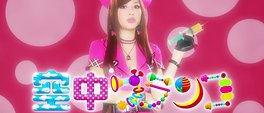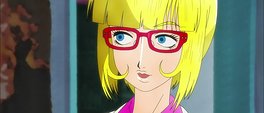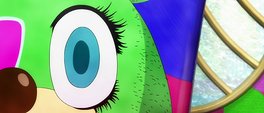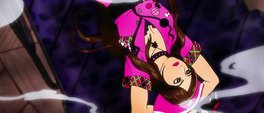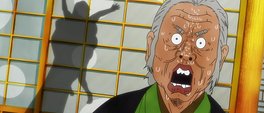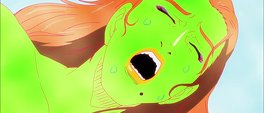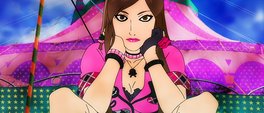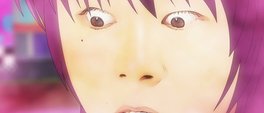Kuchu Buranko (Trapeze, lit. Sky Swing) is like a late night bevy of cocktails: all bright colours and mind altering effects. The first three episodes are an all out assault on aesthetics, everything is awash with luminous colours and textured with polka dots or garish swathes of clashing patterns. Sometimes barely discernible from the backdrops, the characters are animated haphazardly when they are at all, often devolving into poorly filtered live-action or blatant rotoscoping and other times jerking between poses with little warning. Like its closet meretricious sibling, Gankutsuou, the visuals are only meant to allure and the real meat of the episodes is worth risking sensory overload.
The mostly standalone stories are about individuals who have some sort of mental affliction which is examined by the whimsical psychiatrist Ichiro Irabu who changes form between an obnoxious green rabbit with permanent facial stubble, a precocious young boy whose lab coat is several sizes too large for him and an androgynous bespectacled boy in his late teens or early twenties. Even the patients are not immune to switching states, often depicted as animals which suit their condition; topping all of this madness off is a supposedly real life psychiatrist Fukuicchi who sporadically pops out of a scene for an aside on the current disorder being explored. The series so far is raucous, visually boggling and brilliant fun to watch.
There seems little this series won't cover with the second episode dedicated to a man with a permanent erection who has to go through great pains to hide his condition from his work colleagues who are mostly buxom but bossy females. Other episodes deal with a circus performer and romance novelist and, combined with the sultry and provocatively dressed nurse and a cornucopia of other oddball characters, everything is saturated with an energy that matches the neon tones. It is on the strength of the cast that the show relies and by the third episode the particular brand of lunacy wielded by the psychiatrist has dulled and isn't helped by a comparatively flat lead; this could be a portent of episodes to come but with only eleven in total and the strength of prior offerings, the lull is more likely a hiccup than a developing flaw.
Given the barrage of colours, the visuals are always going to be under scrutiny and they are the easiest element to pick fault with. Beyond the scratchy, haphazard style it often feels like a technicolour slideshow than animation and it is left to the faux live-action characters to fill out some of the motions. There are brief flashes of the talent sometimes seen from Toei Animation but otherwise it is backdrops and stills which make up the majority of the runtime. The audio is befitting of the tone of the show with almost Europop opening and ending songs and kitschy sound effects dropped into the episodes at opportune moments; the soundtrack remains as conspicuous as the rest of the show.
In just three episodes Kuchu Buranko proves a beguiling mix of psychological exposition and riotous design; often funny and layered beyond expectations it is a blast to watch and the lengths to which it will go with the remaining eight patients is tantalising. It will likely be lumped into a cult category with other surreal treats such as Kaiba but it is, so far at least, well worth potentially jeopardising one's colour perception to watch.
